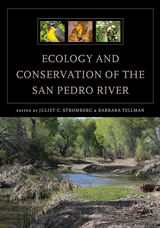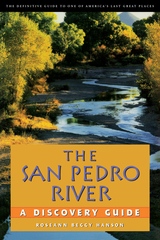2 books about San Pedro River

Ecology and Conservation of the San Pedro River
Edited by Juliet C. Stromberg and Barbara Tellman
University of Arizona Press, 2009
One of the last undammed perennial rivers in the desert Southwest, the San Pedro River in southeastern Arizona illustrates important processes common to many desert riparian ecosystems. Although historic land uses and climatic extremes have led to aquifer depletion, river entrenchment, and other changes, the river still sustains a rich and varied selection of life. Resilient to many factors, portions of the San Pedro have become increasingly threatened by groundwater pumping and other impacts of population growth.
This book provides an extensive knowledge base on all aspects of the San Pedro, from flora and fauna to hydrology and human use to preservation. It describes the ecological patterns and processes of this aridland river and explores both the ongoing science-driven efforts by nonprofit groups and government agencies to sustain and restore its riparian ecosystems and the science that supports these management decisions.
An interdisciplinary team of fifty-seven contributors—biologists, ecologists, geomorphologists, historians, hydrologists, lawyers, political scientists—weave together threads from their diverse perspectives to reveal the processes that shape the past, present, and future of the San Pedro’s riparian and aquatic ecosystems. They review the biological communities of the San Pedro and the stream hydrology and geomorphology that affect its riparian biota. They then look at conservation and management challenges along three sections of the San Pedro, from its headwaters in Mexico to its confluence with the Gila River, describing legal and policy issues and their interface with science; activities related to mitigation, conservation, and restoration; and a prognosis of the potential for sustaining the basin’s riparian system.
These chapters demonstrate the complexity of the San Pedro’s ecological and hydrological conditions, showing that there are no easy answers to the problems—and that existing laws are inadequate to fully address them. Collectively, they offer students, professionals, and environmental advocates a better grasp of the San Pedro’s status as well as important lessons for restoring physical processes and biotic communities to rivers in arid and semiarid regions.
This book provides an extensive knowledge base on all aspects of the San Pedro, from flora and fauna to hydrology and human use to preservation. It describes the ecological patterns and processes of this aridland river and explores both the ongoing science-driven efforts by nonprofit groups and government agencies to sustain and restore its riparian ecosystems and the science that supports these management decisions.
An interdisciplinary team of fifty-seven contributors—biologists, ecologists, geomorphologists, historians, hydrologists, lawyers, political scientists—weave together threads from their diverse perspectives to reveal the processes that shape the past, present, and future of the San Pedro’s riparian and aquatic ecosystems. They review the biological communities of the San Pedro and the stream hydrology and geomorphology that affect its riparian biota. They then look at conservation and management challenges along three sections of the San Pedro, from its headwaters in Mexico to its confluence with the Gila River, describing legal and policy issues and their interface with science; activities related to mitigation, conservation, and restoration; and a prognosis of the potential for sustaining the basin’s riparian system.
These chapters demonstrate the complexity of the San Pedro’s ecological and hydrological conditions, showing that there are no easy answers to the problems—and that existing laws are inadequate to fully address them. Collectively, they offer students, professionals, and environmental advocates a better grasp of the San Pedro’s status as well as important lessons for restoring physical processes and biotic communities to rivers in arid and semiarid regions.
[more]

The San Pedro River
A Discovery Guide
Roseann Beggy Hanson
University of Arizona Press, 2001
The San Pedro River in southeastern Arizona not only features some of the richest wildlife habitat in the Southwest, it also is home to more kinds of animals than anywhere else in the contiguous United States. Here you'll find 82 species of mammals, dozens of different reptiles and amphibians, and nearly 400 species of birds—more than half of those recorded in the entire country. In addition, the river supports one of the largest cottonwood-willow forest canopies remaining in Arizona. It's little wonder that the San Pedro was named by the Nature Conservancy as one of the Last Great Places in the Northern Hemisphere, and by the American Bird Conservancy as its first Important Bird Area in the United States.
Roseann Hanson has spent much of her life exploring the San Pedro and its environs and has written a book that is both a personal celebration of and a definitive guide to this, the last undammed and unchanneled river in the Southwest. Taking you from the San Pedro's entry into the U.S. at the Mexican border to its confluence with the Gila River about a hundred miles north, she devotes a separate chapter to each of seven sections of river. Each chapter contains an eloquent essay on natural and cultural history, laced with Hanson's own experiences, plus an exploration guide brimming with useful information: how to get to the river, finding hiking trails, camping and other accommodations, birdwatching tips, access to biking and horseback riding, and nearby historic sites. Maps are included for each stretch of river, and the text is illustrated throughout with drawings from Roseann's copious field notebooks. Along the 40 miles of the San Pedro Riparian National Conservation Area, a sanctuary protected by the Bureau of Land Management since 1988, Hanson shows how the elimination of cattle and off-road vehicles has restored the river corridor to a more natural condition. She tells of the impact of humans on the San Pedro, from Clovis hunters to American settlers to Washington bureaucrats, and shows how, as the river winds its way north, it is increasingly threatened by groundwater pumping and urbanization.
In addition to the "discovery" sections of each chapter, Hanson has included species checklists for habitats and plants, birds, mammals, and reptiles and amphibians to make this a perfect companion for anyone exploring the area, whether as occasional tourist or frequent visitor. The book's blending of graceful prose and practical information shows that a river is the sum of many parts. Roseann Hanson will give you a special understanding—and perhaps a sense of stewardship—of this wild place.
Roseann Hanson has spent much of her life exploring the San Pedro and its environs and has written a book that is both a personal celebration of and a definitive guide to this, the last undammed and unchanneled river in the Southwest. Taking you from the San Pedro's entry into the U.S. at the Mexican border to its confluence with the Gila River about a hundred miles north, she devotes a separate chapter to each of seven sections of river. Each chapter contains an eloquent essay on natural and cultural history, laced with Hanson's own experiences, plus an exploration guide brimming with useful information: how to get to the river, finding hiking trails, camping and other accommodations, birdwatching tips, access to biking and horseback riding, and nearby historic sites. Maps are included for each stretch of river, and the text is illustrated throughout with drawings from Roseann's copious field notebooks. Along the 40 miles of the San Pedro Riparian National Conservation Area, a sanctuary protected by the Bureau of Land Management since 1988, Hanson shows how the elimination of cattle and off-road vehicles has restored the river corridor to a more natural condition. She tells of the impact of humans on the San Pedro, from Clovis hunters to American settlers to Washington bureaucrats, and shows how, as the river winds its way north, it is increasingly threatened by groundwater pumping and urbanization.
In addition to the "discovery" sections of each chapter, Hanson has included species checklists for habitats and plants, birds, mammals, and reptiles and amphibians to make this a perfect companion for anyone exploring the area, whether as occasional tourist or frequent visitor. The book's blending of graceful prose and practical information shows that a river is the sum of many parts. Roseann Hanson will give you a special understanding—and perhaps a sense of stewardship—of this wild place.
[more]
READERS
Browse our collection.
PUBLISHERS
See BiblioVault's publisher services.
STUDENT SERVICES
Files for college accessibility offices.
UChicago Accessibility Resources
home | accessibility | search | about | contact us
BiblioVault ® 2001 - 2024
The University of Chicago Press









